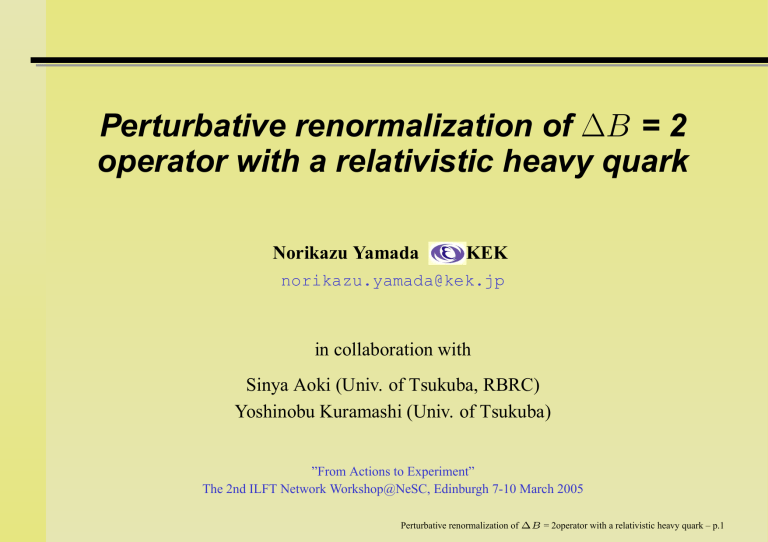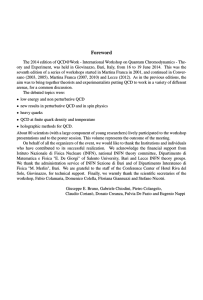∆B Perturbative renormalization of = 2 operator with a relativistic heavy quark
advertisement

Perturbative renormalization of ∆B = 2
operator with a relativistic heavy quark
Norikazu Yamada
KEK
norikazu.yamada@kek.jp
in collaboration with
Sinya Aoki (Univ. of Tsukuba, RBRC)
Yoshinobu Kuramashi (Univ. of Tsukuba)
”From Actions to Experiment”
The 2nd ILFT Network Workshop@NeSC, Edinburgh 7-10 March 2005
Perturbative renormalization of ∆B = 2operator with a relativistic heavy quark – p.1
Introduction
In the Standard Model,
µ
¶
known factor × |Vtb∗ Vtq |2 hB̄q0 |OLL |Bq0 i,
∆MBq =
®
∆MBd
∆MBs
OLL = b̄γµ (1 − γ5 )q b̄γµ (1 − γ5 )q
­
©
ª
:
measured at 3% level
:
will be measured soon (∼ a few %)
Determination of |Vtb∗ Vtq | requires hB̄q0 |OLL |Bq0 i.
Lattice QCD → hB̄q0 |OLL |Bq0 i
target accuracy ∼ a few % uncertainty.
Perturbative renormalization of ∆B = 2operator with a relativistic heavy quark – p.2
Heavy quark on the lattice
Heavy quark on the Lattice → O((amQ )n ) error
amQ ∼ O(1) → O((amQ )n ) ∼ O(1) À O((ap)n )
→ Expansion of errors in (amQ ) is not justified.
⇓
Relativistic heavy quark action (RHQ)
Perturbative renormalization of ∆B = 2operator with a relativistic heavy quark – p.3
Relativistic heavy quark
Aoki, Kuramashi and Tominaga (2003)
SQ =
"
X
m0 Q̄(x)Q(x) + Q̄(x)γ0 D0 Q(x) + νQ
x
X
Q̄(x)γi Di Q(x)
i
rs a X
rt a
2
Q̄(x)D0 Q(x) −
Q̄(x)Di2 Q(x)
−
2
2 i
iga X
iga X
cE
cB
Q̄(x)σ0i F0i Q(x) −
Q̄(x)σij Fij Q(x) ,
−
2
4
i
i,j
• The Fermilab action with a special choice of parameters
[El-Khadra, Kronfeld and Mackenzie (1997)]
• Four parameters (νQ , rs , cE , cB ) to be tuned.
• In mQ → 0, RHQ → the clover action, and
the space-time rotational symmetry is restored.
Perturbative renormalization of ∆B = 2operator with a relativistic heavy quark – p.4
Symanzik improvement (action)
Consider the Symanzik effective action of Wilson type quark action applied to HQ
(O((amQ )n ) ∼ 1 6= O((ap)n )
• Naive O(a) improved Wilson with csw = 1
³
´
.
(0)
+ aL(1) + a2 L(2) + · · ·
Lclover
latt ({cX }) = LQCD + L
leading error ∼ O((amQ )n ) ∼ O(1)
Perturbative renormalization of ∆B = 2operator with a relativistic heavy quark – p.5
Symanzik improvement (action)
Consider the Symanzik effective action of Wilson type quark action applied to HQ
(O((amQ )n ) ∼ 1 6= O((ap)n )
• Naive O(a) improved Wilson with csw = 1
³
´
.
(0)
+ aL(1) + a2 L(2) + · · ·
Lclover
latt ({cX }) = LQCD + L
leading error ∼ O((amQ )n ) ∼ O(1)
• Tree level O((amQ )n (ap)) improvement (RHQ)
³
´
.
RHQ
RHQ
(0)
(1)
2 (2)
Llatt ({cX }) = LQCD + αs L + αs aL + a L + · · ·
leading ∼ O(αs (amQ )n ) ∼ O(αs )
Perturbative renormalization of ∆B = 2operator with a relativistic heavy quark – p.5
Symanzik improvement (action)
Consider the Symanzik effective action of Wilson type quark action applied to HQ
(O((amQ )n ) ∼ 1 6= O((ap)n )
• Naive O(a) improved Wilson with csw = 1
³
´
.
(0)
+ aL(1) + a2 L(2) + · · ·
Lclover
latt ({cX }) = LQCD + L
leading error ∼ O((amQ )n ) ∼ O(1)
• Tree level O((amQ )n (ap)) improvement (RHQ)
³
´
.
RHQ
RHQ
(0)
(1)
2 (2)
Llatt ({cX }) = LQCD + αs L + αs aL + a L + · · ·
leading ∼ O(αs (amQ )n ) ∼ O(αs )
• Improvement through O(αs (amQ )n (ap)) [Aoki, Kayaba, Kuramashi (2003)]
³
´
0
.
O(aαs )
2 (0)
2
(1)
2 (2)
Llatt ({cRHQ
})
=
L
+
α
L
+
α
aL
+
a
L + ···
QCD
s
s
X
leading ∼ O(α2s ) or O((ap)2 )
Perturbative renormalization of ∆B = 2operator with a relativistic heavy quark – p.5
Symanzik improvement (operator)
• Non-improved operator with RHQ
³
´
.
(0)
(1)
(2)
(OLL )latt ({cO }) = (OLL )QCD + αs OLL + αs aOLL + a2 OLL + · · ·
∼ O(αs )
Perturbative renormalization of ∆B = 2operator with a relativistic heavy quark – p.6
Symanzik improvement (operator)
• Non-improved operator with RHQ
³
´
.
(0)
(1)
(2)
(OLL )latt ({cO }) = (OLL )QCD + αs OLL + αs aOLL + a2 OLL + · · ·
∼ O(αs )
• O(αs ) improvement
s
(OLL )latt ({cα
O })
³
´
.
(1)
2 (0)
2 (2)
= (OLL )QCD + αs OLL + αs aOLL + a OLL + · · ·
Perturbative renormalization of ∆B = 2operator with a relativistic heavy quark – p.6
Symanzik improvement (operator)
• Non-improved operator with RHQ
³
´
.
(0)
(1)
(2)
(OLL )latt ({cO }) = (OLL )QCD + αs OLL + αs aOLL + a2 OLL + · · ·
∼ O(αs )
• O(αs ) improvement
s
(OLL )latt ({cα
O })
³
´
.
(1)
2 (0)
2 (2)
= (OLL )QCD + αs OLL + αs aOLL + a OLL + · · ·
• O(αs (ap)) improvement
³
´
.
(0)
(1)
(2)
αs a
}) = (OLL )QCD + αs2 OLL + αs2 aOLL + a2 OLL + · · ·
(OLL )latt ({cO
O(αs ) improvement is presented in the following.
O(αs (ap)) improvement is now in progress.
Perturbative renormalization of ∆B = 2operator with a relativistic heavy quark – p.6
Basis of four-quark operators
The leading four-quark operator :
Q̄γµ L q Q̄γµ L q
←
(L/R
=
Q
q
: relativistic heavy quark with mQ
: clover light quark mq = 0
1 ∓ γ5 )
12 dimension six operators Q̄ΓX q Q̄ΓY q could mix at O(αs ):
(ΓX , ΓY ) =
(γ4 L, γ4 L), (γi L, γi L), ← leading ones
(γ4 R, γ4 R), (γi R, γi R), (γ4 L, γ4 R), (γi L, γi R),
(L, L), (R, R), (L, R),
(γ4 γi L, γ4 γi L), (γ4 γi R, γ4 γi R), (γ4 γi L, γ4 γi R)
In general, γ4 Γ and γi Γ have different coefficients due to the violation of the
space-time rotational symmetry.
Perturbative renormalization of ∆B = 2operator with a relativistic heavy quark – p.7
Definitions of improvement coefficients
MS
OLL
(µ)
=
(0)
Znorm
"½
2
2 2
ln(a
µ )
1−g
2
(4π)
2
¾
lattt
OLL
−g
2
X
#
latt
CX OX
,
X
where
(0)
(0)
(0)
= ZQ,latt (mQ ) Zq,latt (mq = 0) : tree-level wave function
Znorm
X = { 4Lx4L, iLxiL, 4Rx4R, iRxiR, 4Lx4R, iLxiR,
LxL, RxR, LxR, 4iLx4iL, 4iRx4iR, 4iLx4iR }
The twelve coefficients CX are calculated as functions of mQ .
Perturbative renormalization of ∆B = 2operator with a relativistic heavy quark – p.8
'
Properties of the coefficients
MS
OLL
(µ)
=
(0)
Znorm
"½
2
2 2
ln(a
µ )
1−g
2
(4π)
2
¾
lattt
OLL
−g
2
X
latt
CX OX
X
#
$
X = { 4Lx4L, iLxiL, 4Rx4R, iRxiR, 4Lx4R, iLxiR,
&
LxL, RxR, LxR, 4iLx4iL, 4iRx4iR, 4iLx4iR }
As mQ → 0, the space-time rotational symmetry is restored.
%
Then, the following must hold:
• C4Lx4L − CiLxiL → 0
← leading ones
• C4Lx4R − CiLxiR → 0
• C4iLx4iR → 0
Perturbative renormalization of ∆B = 2operator with a relativistic heavy quark – p.9
Calculational method
• Lattice : Construct Feynman diagrams for the on-shell amp, and classify them by
uq (p1)
ūb (q2)
Tr
"Ã
Γ2
vq (−p2)
+
Γ1
v̄b (−q1)
uq (p1)
ūb (q2)
Γ2
vq (−p2)
+
Γ1
v̄b (−q1)
uq (p1)
ūb (q2)
Γ2
vq (−p2)
+
Γ1
v̄b (−q1)
uq (p1)
ūb (q2)
Γ2
vq (−p2)
Γ1
!
v̄b (−q1)
Γ
#
(Γ = {1 × 1, γ5 × γ5 , · · · }) → clatt
X (k) in Fortran form
Perturbative renormalization of ∆B = 2operator with a relativistic heavy quark – p.10
Calculational method
• Lattice : Construct Feynman diagrams for the on-shell amp, and classify them by
uq (p1)
ūb (q2)
Tr
"Ã
Γ2
vq (−p2)
+
Γ1
v̄b (−q1)
uq (p1)
ūb (q2)
Γ2
vq (−p2)
+
Γ1
v̄b (−q1)
uq (p1)
ūb (q2)
Γ2
vq (−p2)
+
Γ1
v̄b (−q1)
uq (p1)
ūb (q2)
Γ2
vq (−p2)
Γ1
!
v̄b (−q1)
Γ
#
(Γ = {1 × 1, γ5 × γ5 , · · · }) → clatt
X (k) in Fortran form
• Continuum: Repeat above → ccont
X (k) in Fortran form
Perturbative renormalization of ∆B = 2operator with a relativistic heavy quark – p.10
Calculational method
• Lattice : Construct Feynman diagrams for the on-shell amp, and classify them by
uq (p1)
ūb (q2)
Tr
"Ã
Γ2
vq (−p2)
+
Γ1
uq (p1)
ūb (q2)
Γ2
vq (−p2)
v̄b (−q1)
+
Γ1
v̄b (−q1)
uq (p1)
ūb (q2)
Γ2
vq (−p2)
+
Γ1
uq (p1)
ūb (q2)
Γ2
vq (−p2)
v̄b (−q1)
Γ1
!
v̄b (−q1)
Γ
#
(Γ = {1 × 1, γ5 × γ5 , · · · }) → clatt
X (k) in Fortran form
• Continuum: Repeat above → ccont
X (k) in Fortran form
• Perform numerical integration of
latt−cont
CX
=
Z
+π
d4 k
−π
„
2
2 cont
clatt
X (k) − θ(k − π ) cX (k)
«
← infrared free
Perturbative renormalization of ∆B = 2operator with a relativistic heavy quark – p.10
Calculational method
• Lattice : Construct Feynman diagrams for the on-shell amp, and classify them by
uq (p1)
ūb (q2)
Tr
"Ã
Γ2
+
Γ1
vq (−p2)
uq (p1)
ūb (q2)
Γ2
+
Γ1
vq (−p2)
v̄b (−q1)
v̄b (−q1)
uq (p1)
ūb (q2)
Γ2
+
Γ1
vq (−p2)
uq (p1)
ūb (q2)
Γ2
vq (−p2)
v̄b (−q1)
Γ1
!
v̄b (−q1)
Γ
#
(Γ = {1 × 1, γ5 × γ5 , · · · }) → clatt
X (k) in Fortran form
• Continuum: Repeat above → ccont
X (k) in Fortran form
• Perform numerical integration of
latt−cont
CX
=
Z
+π
d4 k
−π
„
2
2 cont
clatt
X (k) − θ(k − π ) cX (k)
«
← infrared free
• In addition, analytically estimate
cont+MS
CX
=
Z
+π
4
2
d k θ(k − π
−π
2
) ccont
X (k)
−
Z
+∞
d4 k ccont
X (k) ← infrared free
−∞
Perturbative renormalization of ∆B = 2operator with a relativistic heavy quark – p.10
Calculational method
• Lattice : Construct Feynman diagrams for the on-shell amp, and classify them by
uq (p1)
ūb (q2)
Tr
"Ã
Γ2
+
Γ1
vq (−p2)
uq (p1)
ūb (q2)
Γ2
+
Γ1
vq (−p2)
v̄b (−q1)
v̄b (−q1)
uq (p1)
ūb (q2)
Γ2
+
Γ1
vq (−p2)
uq (p1)
ūb (q2)
Γ2
vq (−p2)
v̄b (−q1)
Γ1
!
v̄b (−q1)
Γ
#
(Γ = {1 × 1, γ5 × γ5 , · · · }) → clatt
X (k) in Fortran form
• Continuum: Repeat above → ccont
X (k) in Fortran form
• Perform numerical integration of
latt−cont
CX
=
Z
+π
d4 k
−π
„
2
2 cont
clatt
X (k) − θ(k − π ) cX (k)
«
← infrared free
• In addition, analytically estimate
cont+MS
CX
=
Z
+π
4
2
d k θ(k − π
2
) ccont
X (k)
−π
latt−cont
cont+MS
CX = C X
+ CX
−
Z
+∞
d4 k ccont
X (k) ← infrared free
−∞
† For C4Lx4L and CiLxiL , take into
account ZQ and Zq .
Perturbative renormalization of ∆B = 2operator with a relativistic heavy quark – p.10
Numerical integration
The momentum integrations are performed
• by discrete mom sum with L4 = 244 (→ 484 in progress),
• for plaquette, Iwasaki and DBW2 gauge actions.
• in 0 ≤ mQ ≤ 5.0
CX are given as a function of mQ .
Perturbative renormalization of ∆B = 2operator with a relativistic heavy quark – p.11
Results
At mQ = 0, we confirmed
• the previous result
4Lx4L
iLxiL
4Lx4R
iLxiR
4iLx4iR
LxL, 4iLx4iL
LxR
RxR, 4iRx4iR
4Rx4R, iRxiR
[Frezzotti
plaquette
et al. (1991)]
0.2
• C4Lx4R = CiLxiR
• C4iLx4iR = 0
CX
• C4Lx4L = CiLxiL
0.1
Furthermore, it is turned out that
• CLxL = C4iLx4iL ,
• CRxR = C4iRx4iR = const,
• C4Rx4R = CiRxiR = 0
independently of mQ ,
0
0
1
2
mQ
3
4
5
Only C4Lx4L , CiLxiL , C4Lx4R , CiLxiR are sizable.
Perturbative renormalization of ∆B = 2operator with a relativistic heavy quark – p.12
Results
At mQ = 0, we confirmed
• the previous result
4Lx4L
iLxiL
4Lx4R
iLxiR
4iLx4iR
LxL, 4iLx4iL
LxR
RxR,4iRx4iR
4Rx4R, iRxiR
[Frezzotti
Iwasaki
et al. (1991)]
0.2
• C4Lx4R = CiLxiR
• C4iLx4iR = 0
CX
• C4Lx4L = CiLxiL
0.1
Furthermore, it is turned out that
0
• CLxL = C4iLx4iL ,
• CRxR = C4iRx4iR = const,
• C4Rx4R = CiRxiR = 0
independently of mQ ,
0
1
2
mQ
3
4
5
All coefficients become smaller for Iwasaki
gauge.
Perturbative renormalization of ∆B = 2operator with a relativistic heavy quark – p.12
Results
At mQ = 0, we confirmed
• the previous result
4Lx4L
iLxiL
4Lx4R
iLxiR
4iLx4iR
LxL, 4iLx4iL
LxR
RxR, 4iRx4iR
4Rx4R, iRxiR
[Frezzotti
et al. (1991)]
DBW2
• C4Lx4L = CiLxiL
• C4iLx4iR = 0
CX
• C4Lx4R = CiLxiR
0.2
0.1
Furthermore, it is turned out that
• CLxL = C4iLx4iL ,
• CRxR = C4iRx4iR = const,
• C4Rx4R = CiRxiR = 0
0
0
1
2
mQ
3
4
5
independently of mQ ,
Perturbative renormalization of ∆B = 2operator with a relativistic heavy quark – p.12
Mean field improvement
[Lepage and Mackenzie (1993)]
• No improved case
4Lx4L no imp
iLxiL no imp
MF
Plaquette
CX and CX
Only the leading ones are affected at
one-loop level.
0.2
0.1
0
0
1
2
mQ
3
4
Perturbative renormalization of ∆B = 2operator with a relativistic heavy quark – p.13
5
Mean field improvement
[Lepage and Mackenzie (1993)]
• No improved case
• Mean field
Mass dependence becomes mild.
4Lx4L no imp
iLxiL no imp
4Lx4L MF
iLxiL MF
MF
Plaquette
CX and CX
Only the leading ones are affected at
one-loop level.
0.2
0.1
0
0
1
2
mQ
3
4
Perturbative renormalization of ∆B = 2operator with a relativistic heavy quark – p.13
5
Mean field improvement
[Lepage and Mackenzie (1993)]
• No improved case
• Mean field
Mass dependence becomes mild.
MF
0.2
0.1
0
0
The same is true for RG-improved
gauge actions.
4Lx4L no imp
iLxiL no imp
Iwasaki
CX and CX
Only the leading ones are affected at
one-loop level.
1
2
mQ
3
4
Perturbative renormalization of ∆B = 2operator with a relativistic heavy quark – p.13
5
Mean field improvement
[Lepage and Mackenzie (1993)]
• No improved case
• Mean field
Mass dependence becomes mild.
MF
0.2
0.1
0
0
The same is true for RG-improved
gauge actions.
4Lx4L no imp
iLxiL no imp
4Lx4L MF
iLxiL MF
Iwasaki
CX and CX
Only the leading ones are affected at
one-loop level.
1
2
mQ
3
4
Perturbative renormalization of ∆B = 2operator with a relativistic heavy quark – p.13
5
Mean field improvement
[Lepage and Mackenzie (1993)]
• No improved case
• Mean field
Mass dependence becomes mild.
The same is true for RG-improved
gauge actions.
4Lx4L no imp
iLxiL no imp
MF
DBW2
CX and CX
Only the leading ones are affected at
one-loop level.
0.2
0.1
0
0
1
2
mQ
3
4
Perturbative renormalization of ∆B = 2operator with a relativistic heavy quark – p.13
5
Mean field improvement
[Lepage and Mackenzie (1993)]
• No improved case
• Mean field
Mass dependence becomes mild.
MF
0.2
0.1
0
0
The same is true for RG-improved
gauge actions.
4Lx4L no imp
iLxiL no imp
4Lx4L MF
iLxiL MF
DBW2
CX and CX
Only the leading ones are affected at
one-loop level.
1
2
mQ
3
4
Perturbative renormalization of ∆B = 2operator with a relativistic heavy quark – p.13
5
Conclusion
• The O(αs (amQ )n ) improvement coefficients for the ∆B=2
operator consisting of the relativistic heavy and the clover
light quarks are determined.
• Meanfield improvement makes the mass dependence mild.
For future,
• Applying to other quark actions is easy.
e.g. RHQ + domain-wall light quarks, etc.
• O(αs (amQ )n (ap)) improvement
→ dimension seven operators.
• Lattice simulation → a few % determination of hB̄q0 |OLL |Bq0 i
Perturbative renormalization of ∆B = 2operator with a relativistic heavy quark – p.14


